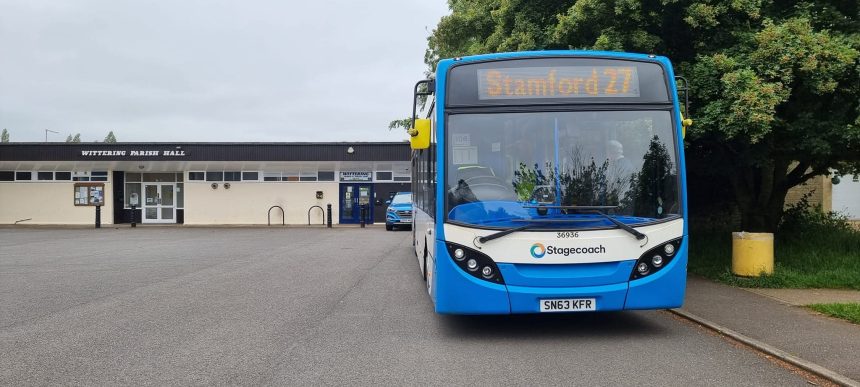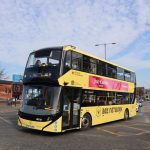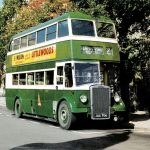The role of community bus partnerships is arguably as crucial as ever. Due to increased devolution, more of the money for bus services will in future be in the hands of local leaders.
The part volunteers in the community can play in promoting their local bus services is not to be underestimated. That has been highlighted by David Boden, Commercial Director of Stagecoach East.
Long a champion of integrated transport services, David co-authored a paper for the Department for Transport in 2016 on how to unlock the power of community rail partnerships to include bus. David notes that community rail partnerships have delivered “phenomenally good results”.
For example, he cites the Yorkshire Coast Community Rail Partnership, which was set up in 1999 by a membership of individuals and community groups from several councils at various levels, as growing passengers by 45%.
He maintains the belief that these rail groups could be expanded to cover bus. Unfortunately, he says little was done in response to the research he and Chris Blake carried out.

Nevertheless, he highlights the work that can be done by local volunteers to keep endangered bus services going.
If operators can embrace the power of community bus partnerships, then local and combined authorities may be more likely to find the funding to tender out the service to them.
On a large scale, the DalesBus network centred around the Yorkshire Dales has been a huge success. Despite the Dales and Bowland Community Interest Company’s battle to meet the £250,000 annual cost of contracting services to local operators, it recorded 53,388 passengers in 2023/24, an increase of 28% on the previous year.
On the Isle of Wight, the model is taken a step further with volunteers driving buses supplied by Southern Vectis. The operator also funds training, fuel and insurance in an arrangement which began in 2011 to save routes which would otherwise have been axed.
David and Chris’s research concluded that, for such partnerships to be successful, “passionate committed volunteers” were essential. Also needed was a clear mission statement, good information regarding services, as well as paid staff or resources from the local authority.
Campaign success marked in Peterborough
A community bus partnership David is enthusiastic about celebrated the first anniversary of bearing fruit recently.
The Bus Service through Castor, Ailsworth, Wansford and Wittering campaign group was formed after the service which connected the villages of Wittering, Wansford, Castor and Ailsworth with Peterborough and Stamford was cut.
A near-two-year campaign led to the reintroduction of the connection in June 2024 as the number 27 route, run by Stagecoach East.
Describing the group, David says that, in his professional career, he has not met people with such “passion and tenacity”.

The evidence from all concerned suggests those qualities were key to getting the service back up and running.
It appears campaigners offer the perfect example of what can be achieved and how operators can benefit from working with the community in such a way.
Central to the campaign are Susan Magill and Julia Cunnington, while Alan Dowson and Nick Sandford, who were then Mayor and Deputy Mayor respectively of Peterborough, played a part in getting it the attention it needed.
“There was a period when there was no bus service at all and it caused a lot of inconvenience for people living in Castor, Ailsworth, Wansford and Wittering,” says Nick.
Since the service had been axed, the Cambridgeshire and Peterborough Combined Authority had taken over responsibility from Peterborough City Council for subsidising bus routes.
I think they could write the book on how to be a community champion campaign group… They are tenacious, they will not let things go – Anna Smith
“We were approached by Susan and other people and we were able to introduce them to [Cambridgeshire and Peterborough Mayor] Nik Johnson,” explains Nick.
In testament to the respect for the campaigners, the first anniversary celebration in Wittering was attended by now former Mayor Nik, his then Deputy and Transport Lead Anna Smith, local MP Sam Carling, and Peterborough Mayor Judy Fox.
Speaking at that meeting, Anna recalls: “I remember at the combined authority transport committee, where this campaign group first came along, and they were amazing. They turned up and they presented us with all the evidence and they didn’t go away; they kept coming back!
“They are genuinely a phenomenal campaign group. I think they could write the book on how to be a community champion campaign group.
“They have been amazing and easy to work with. They are tenacious, they will not let things go, which is absolutely what you want.” They returned for further meetings to make sure it stayed on the agenda, she says.
She adds that the crucial moment in the process was when she visited Wittering and walked some of the way along a narrow path next to the A1 dual carriageway which residents were facing daily to make important appointments in the absence of the bus service.
She says: “When you’ve walked down the A1 and you’ve seen and felt those cars coming past you and you realise that this is the route that children and older people are having to take to get to schools and GPs, it was such a clear choice that what we needed to do was to make sure that route was in place.”
Community bus partnerships and effective campaigns
Nik concedes that, in his time as Mayor, pleas for funding to reinstate or maintain bus services were plentiful. However, Nik, who chose not to stand again this year due to health reasons, adds: “The difference with this group was that they came along with a strategy, and a strategy to make sure that we didn’t forget about it.
“The difference was there was an evidence base that we could look at. It was the fact that, overwhelmingly, their campaign was based around care. They put together a narrative which was absolutely compelling.”
The bus service’s Facebook group has 800 members and Julia points out it is vital to keep publicising the service, sending out the “use it or lose it” message.

“We’re constantly putting stuff out there, updating what is happening, giving people an idea of what they could do in the area via bus that they might not think about,” she says.
“We’re trying to get people to come out of Peterborough and Stamford into the villages by bus.”
To that end, they enlisted the help of local cartoonist John Elson to produce a visual representation of the bus route and the local attractions it serves. It helped the service gain traction on social and mainstream media.
The difference with this group was that they came along with a strategy … to make sure that we didn’t forget about it – Dr Nik Johnson
Sue highlights that the service has been invaluable to the community. “It’s essential to young people as well, people with disability, people who want to be independent,” she says.
Community bus partnerships can drive impressive patronage
One year on from the number 27 bus starting up, the numbers are encouraging — even if combined authority budget restraints, as ever, mean it is vital for the group to keep proving it is needed.
The service has accumulated 2,200 passengers per month in the six months up to the anniversary — an increase of 21% over the previous six months.
“That’s not commercial, but to get that in a tendered bus service is pretty darn good and it’s down to the tenacity, passion and vision of the group,” says David.

Such is the support of Stagecoach East for the service, it invested £6,000 in new timetable cases for the route. “We don’t normally do that for tendered services,” says David. The operator also has a separate page for the route and its timetable on its website, highlighting the key local attractions – as opposed to the usual timetable search facility.
According to David, what is happening in the villages around Peterborough and Stamford perfectly demonstrates how partnerships between authorities, the community and operators can work together for the good of the local transport network. “It’s inspirational and shows how it can be done,” says David.


























